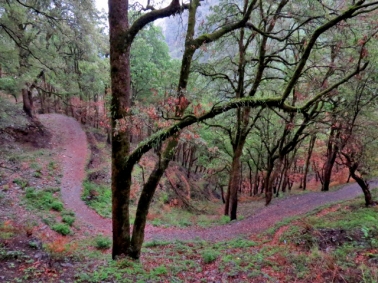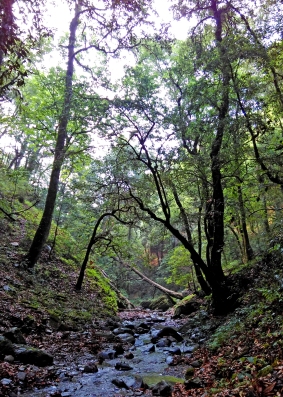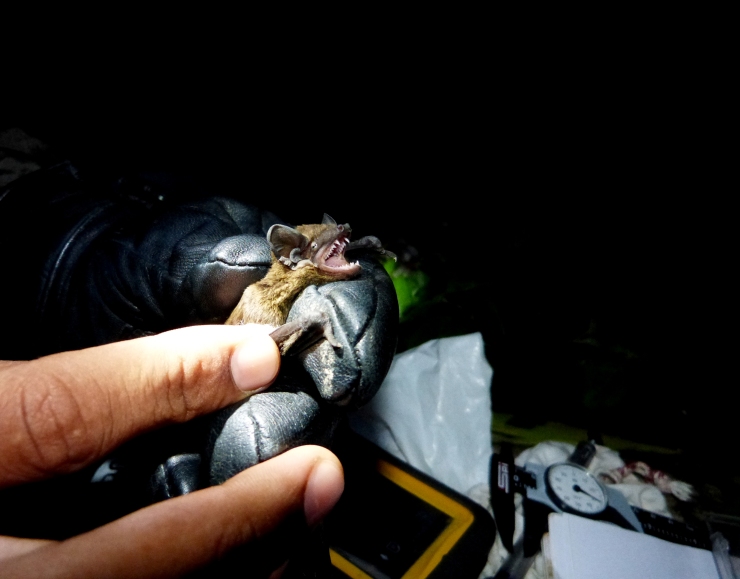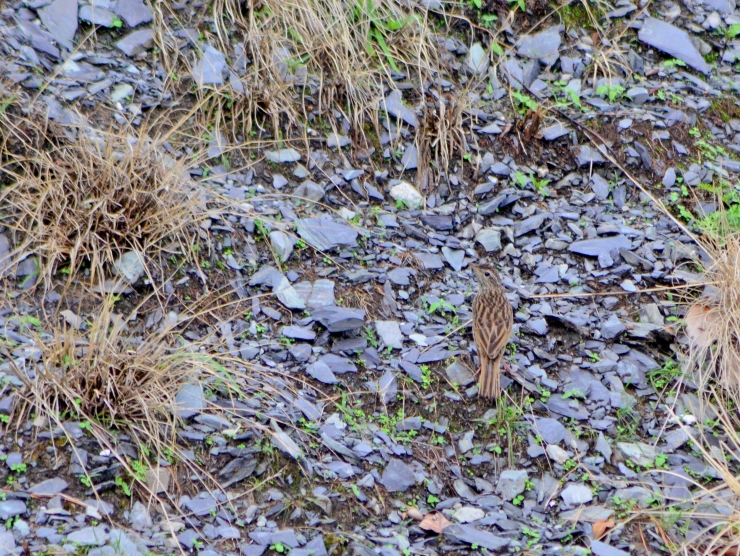“jisne forest ko raat me nahi dekha, usne kuch nahi dekha,” (one who hasn’t seen the forest at night, hasn’t seen anything) was what Rohit said as Zareef and I sat, intently listening to him. A stream flowed by us with its soft, gurgling sound, in the cold, dark forest. The sky was covered with clouds, and along with the tall trees and the distant call of some forest dwelling frogs, the ambience of the place was surreal, something like I had never experienced before. Perhaps the thing about darkness is that it makes you aware of your own presence in a suspiciously beautiful way.
The watch read 9pm, as we sat there in the darkness, occasionally switching on the headlamp and focusing the light towards the spot where the ‘sound’ came from, or towards my bag to take out a packet of biscuit. The mist nets were set further upstream, and all we could do was wait. For what, you say?
Bats!
Catching the Chiropterans
It all started one fine morning, when a sudden realization dawned on me that I was doing nothing in the long, hot summer vacation. I pinged Rohit, with the hope that I could volunteer under him in his research project on bats in Uttarakhand. A confirmatory text from him set the wheels in motion. I soon found myself on a bus to nainital, and then onwards to Pangot, a small dreamy village 20km from Nainital. Jungle lore birding lodge, set beautifully in the village, hosted us for the duration of our stay.

Later that day, Rohit and Zarif, his field assistant, arrived. Rohit chakravarty, an NCBS Bangalore graduate, is currently working on documentation and call library of bat species found in the state of Uttarakhand. Rohit explained in details what we were going to do, and it sounded both interesting and fun ( and not to mention a little frightening, because I had never been to a forest at night! ).
We soon surveyed the area around the village, and came across a forest stream that seemed like a decent site to catch bats. Why a stream? Because it offers a good and uninterrupted passageway for the bats to fly in the forest.
The next day, we set out with our mist nets and poles. After a tiring walk on a slippery trail, we reached the stream. Keeping our bags on top of a rock, we walked upstream, jumping on top of stones and wading in the fast flowing waters. At one location, we set up the two poles on both sides of the stream, while they taught me how to fold and tie the mistnets. Two more mistnets were fixed downstream, and we returned to our lodge, only to come back there again at night.

Night in a forest is completely different. A certain chill exists in the atmosphere, as the soft moon light seeps in through the canopy, and provides just enough light to remove the blinding darkness. The soft murmur of the stream,and the very distant call of a mountain scops owl gave us the reassurance that we weren’t alone. At around 7:30pm, we opened the mistnets and returned to our site. Occasionally, we would talk and share stories over a packet of biscuits, while at other times, it was just the silence that we embraced. I was always wary of leeches, and every now and then, I had the feeling that a leech was crawling up my neck, or sucking on blood from my foot, without my knowledge.
We would go check on the nets at regular intervals, initially with no luck. The bat detector picked up a few calls, but no bats were caught. What was wrong? With not much hope in our hearts, we walked upstream to the mistnet site, and finally, we saw something entangled on the net. It was my first bat!

Rohit went up to the net and very patiently disentangled the bat, before putting it on a weighing bag. We brought it back to our site, and began to take a wide range of data. From weighing the bat, to taking measurements of the forearm,hindfoot, metacarpals, to sketching the wings. These measurements are very important as they help one to ascertain what species of bat we have caught. This particular individual was a species of bat under the family vespertillionidae ( evening bats ), commonly called the lesser noctule. After all the measurements were taken, he handed the bat to me. As I kept it in a firm (yet nervous) grip on my leather gloved hand, I realized just how fragile the bat was. It was hardly 7cm in length,and weighed jus 12.5g!Finally, the blood sample was taken and the bat was released, during which its call was also recorded.
During the next 2-3 days that we sampled in and around Pangot, we returned home without any catch. Why this sudden drop in activity? Two hypothesis were drawn up; due to the full moon, the activity of bats reduce drastically. The second more probable hypothesis was that it was the breeding season and the females were busy nursing their young ones. We even came across a female woolly horseshoe bat with its pup In a small abandoned house, which we left undisturbed.

At powalgarh, we had a bit of a luck when another species of bat was caught from a tunnel over a canal. It was a myotis, and was smaller than the noctule we had previously caught. Despite taking the measurements, confusion exists about what species of bat it is, but its most likely the whiskered bat.
Birds, you ask?
While bats were our prime interest, the birder in me ( and Rohit as well. He is a master birder!) was always on the lookout. And more so, because my life list read 391. Pangot, as is well known to many, is a birder’s paradise. The usual residences of pangot, like the black headed jay and the streaked laughingthrush welcomed us on the first day with a diverse range of calls, while the striated laughingthrush kept itself busy with a mouthful of apricots from the garden. A flock of slaty headed parakeets did their usual rounds around the lodge, and the resident pair of verditer flycatchers took turns in collecting nesting material before vanishing Into the undergrowth, where their nest is.

On all the days, we would go birding in and around the village, bagging Eurasian hobby, fire breasted flowerpecker, long billed thrush, bronzed drongo, several species of woodpeckers, Himalayan cuckoo, a wonderful maroon oriole, and many other species , some of which also kept my life list ticking.
On the day before leaving pangot, we made a short trip to Vinayak, a village further uphill, which is a good location to look for the koklass and cheer pheasants. We walked on the road famously called the ‘cheer point’. Standing at a high vantage point,

with steep slopes on both sides,we witnessed the clouds playing hide and seek with the hills below us. Sometimes it would clear up and the bright blue sky would quench the thirst of our eyes, while at other times, the smoky clouds rising from certain parts of the hill would go on to cover the azure sky. A flock of greenfinches foraged on the road, while a male verditer perched precariously at the edge of the cliff, serenading with no care in the world. A blue capped rock thrush perched on a dry branch, and that’s when, singing and flying, an upland pipit landed on the meadow, walked around nervously, before taking to the skies again. I was happy. This rare Western Himalayan species was my 400th bird, and it could not have been more perfect!

On the last day of my volunteering with Rohit, after packing our stuffs, we came across a charismatic brown fish owl, again a lifer, sitting silently on the river bed. Its eyes gleamed in the light of our headlamps, but it remained undisturbed. Like an old man with a hump, and hands at the back, the owl walked on the river bed, in search of fish. I did not have a camera this time, but it was okay. The moment was far better etched in my memory.
The owl took off to a higher perch, and so did we.
The past week had been a whirlwind of an experience, with the best of company in the best of places. Be it the long wait for the bats, or the several walks in the forest, looking for birds, or just sitting and talking with this crazy bunch of people over a bowl of nachos, I had one of the best field experience one could ever hope to have, and this is the perk of being in love with the wild; you always get much more than you can ever expect.
On the last day, as we sat by the stream in Dehradun, talking, Rohit adds on, saying, “ jisne raat ko forest me stories nahi suna, usne kuch nahi suna.’’
Intrigued?
That’s a different story.
P.S- this story was published in Sanctuary Asia- March 2017

